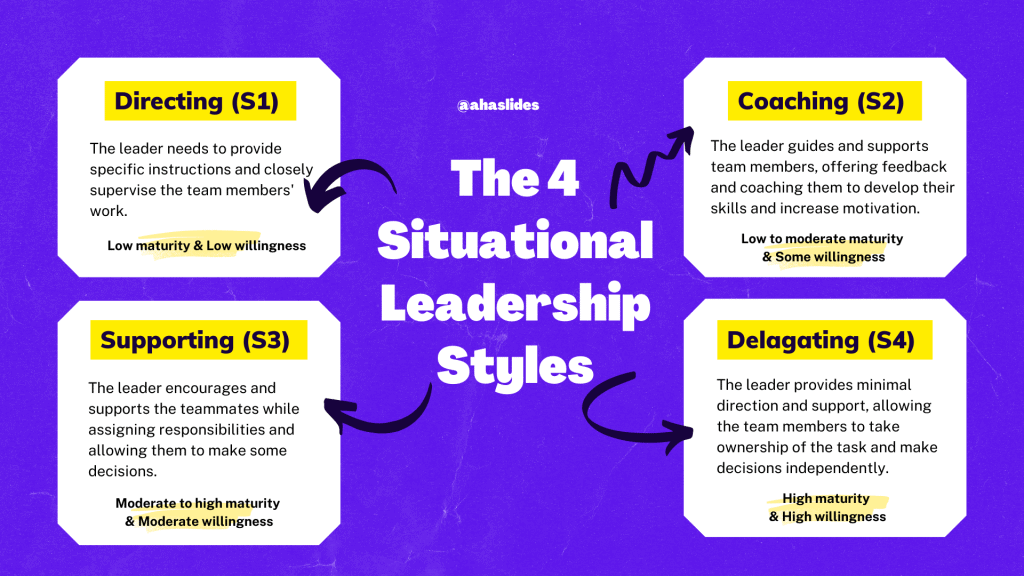Are you new to a management position and confused about which leadership style to use? Are you struggling to determine which is most suited to your personality? Don't worry, you're not alone. Many newly appointed managers face this challenge.
The good news is that there is a solution that doesn't require you to force yourself into any particular style. This strategy is called situational leadership. Therefore, in this article, we'll define situational leadership and discuss how it might help you as a manager.
Table of Contents
- What Is Situational Leadership?
- What Are The 4 Situational Leadership Styles?
- Situational Leadership Examples
- Benefits Of Situational Leadership
- Disadvantages Of Situational Leadership
- Key Takeaways
- Frequently Asked Questions
More on Leadership with AhaSlides
| Name of the book with the term 'situational leadership'? | Paul Hersey |
| What book was it published in? | 1969 |
| Who invented the situational approach? | Management of Organizational Behavior: Utilizing Human Resources |
| Who invented situational approach? | Hersey and Blanchard |
- Leadership style examples
- Autocratic leadership
- Transactional leadership
- Good leadership skills
- Transformational leadership example
- Continuous improvement examples

Looking for a tool to engage your team?
Gather your team members by a fun quiz on AhaSlides. Sign up to take free quiz from AhaSlides template library!
🚀 Grab Free Quiz☁️
What Is Situational Leadership?
Situational Leadership is a leadership approach based on the Situational Leadership Theory, which suggests that there is no one-size-fits-all leadership style for all situations, and great leaders must adjust their method depending on cases to meet the specific needs of team members based on their level of maturity and willingness to take on responsibilities.

But how can managers assess the maturity level and willingness level of employees? Here is a guide:
1/ Maturity Levels
The four levels of maturity are defined as follows:
- M1 - Low Competence/Low Commitment: Team members at this level have limited experience and skills. They need detailed instruction, direction, and supervision to complete the task successfully.
- M2 - Some Competence/Variable Commitment: Team members have some experience and skills related to the task or goal, but they may still be uncertain or lack the confidence to perform consistently.
- M3 - High Competence/Variable Commitment: Team members have significant experience and skills, but they may lack motivation or confidence to complete tasks to the best of their ability.
- M4 - High Competence/High Commitment: Team members have extensive experience and skills, and they can work independently or even suggest improvements to the task or goal.

2/ Willingness Levels
Willingness levels refer to the degree of readiness and motivation of employees to accomplish a task or goal. There are four different levels of willingness:
- Low willingness: At this level, team members are unwilling to take responsibility for completing the task or goal. They may also feel unsure or insecure about their ability to perform the task.
- Some willingness: Team members are still unable to take full responsibility for the task, but they are willing to learn and improve their skills.
- Moderate willingness: Team members can take responsibility for the task but lack the confidence or motivation to do so independently.
- High willingness: Team members are both able and willing to take full responsibility for the task.
By understanding the above two levels, leaders can apply leadership styles that match each stage. This helps team members develop their skills, build their confidence, and increase their motivation, ultimately leading to improved performance and results.
However, how to match leadership styles with these levels effectively? Let's find out in the following sections!
What Are The 4 Situational Leadership Styles?
The Situational Leadership model, developed by Hersey and Blanchard, suggests 4 leadership styles that match with willingness and maturity levels of the team members, as follows:

- Directing (S1) - Low maturity and Low willingness: This method is best suited for new team members who require clear guidance and direction from their leader. And to ensure that their teammates do the assignment successfully, the leader must provide specific instructions.
- Coaching (S2) - Low to moderate maturity and Some willingness: This approach is appropriate for those who have some expertise with the task but lack the confidence to do it independently. The leader must provide guidance and coach their team members to help them develop their skills and increase their motivation.
- Supporting (S3) - Moderate to high maturity and Moderate willingness: This method is best for team members who have professional knowledge and confidence in accomplishing a task but may need encouragement and support to perform at their best. The leader needs to allow the teammates to make decisions and take ownership of the task.
- Delegating (S4) - High maturity and High willingness: This style is best suited for those who have significant experience and confidence in completing a task with additional responsibility. The leader just needs to provide minimal direction and support, and the team members can make decisions independently.
By matching the appropriate leadership style to the team members' level of development, leaders can maximize the follower's potential and achieve better outcomes.
Situational Leadership Examples
Here's an example of how Situational Leadership might be applied in a real-world situation:
Let's say you are a manager at a software development company, and you have a team of four developers. Each of these developers has a different level of skill and experience, and they are all working on a project together. So, you have to adjust your leadership style depending on their development levels.
| Team Member | Develoment Levels (Maturity and Willingness) | Situational Leadership Styles |
| Developer A | She is highly skilled and experienced and needs very little direction | Delegating (S4): In this case, you would delegate tasks to them and let them work independently, only checking in occasionally to make sure everything is on track. |
| Developer B | He is skilled but lacks experience. He needs some guidance and direction but is capable of working independently once he understands what's expected of him. | Supporting (S3): In this case, you should provide clear instructions and check in frequently to answer any questions and provide feedback. |
| Developer C | She is less skilled and less experienced. He needs more guidance and direction and may need some coaching to develop their skills. | Coaching (S2): In this case, you would provide clear instructions, monitor their progress closely, and provide regular feedback and coaching. |
| Developer D | He is new to the company and has limited experience with the technology you are working with. They need step-by-step guidance and direction and will need extensive training and support to get up to speed. | Directing (S1): In this case, you would provide extensive training, and closely monitor their progress until they can work more independently. |
Besides, you can refer to examples of situational leaders, such as George Patton, Jack Stahl, and Phil Jackson, to observe and learn from their way.
Benefits of Situational Leadership
A successful leader must be able to recognize talent, nurture it, and position it in the appropriate place to help his teammates develop.
Adjusting your leadership style regularly to meet the needs of your employees will be sometimes difficult, but it will undoubtedly be beneficial. Here are some situational leadership benefits:
1/ Increase Flexibility
Situational leadership allows leaders to be more flexible in their approach to leading their teams. Leaders can adapt their leadership style to suit the situation, which can result in improved performance and outcome.
2/ Improve Communication
Contrasting autocratic leadership with one-way communication, Situational Leadership emphasizes the importance of effective communication between the leader and the team members. By talking and sharing, situational managers can better understand their teammate's strengths and weaknesses and provide them with support and guidance.
3/ Build Trust
When situational leaders take time to provide the appropriate level of support and guidance, they can demonstrate their commitment to their team members' success, which can lead to increased trust and respect.
4/ Create Motivation with Better Performance
When leaders take a situational approach to leadership, they are more likely to involve their followers in career development to offer helpful guidance and advice. This can lead to improved engagement and motivational employees, which can result in better performance and outcomes.
5/ Create A Healthy Working Environment
Situational Leadership may help to build a healthy culture that values open communication, respect, and trust, and help employees feel comfortable sharing their thoughts and ideas.

Disadvantages Of Situational Leadership
Although Situational Leadership can be a beneficial leadership model, there are several situational leadership disadvantages to consider:
1/ Time-consuming
Applying Situational Leadership requires leaders to devote a lot of effort and time to assessing the requirements of their followers and adapting their leadership style accordingly. This requires patience and may not be possible in some fast-paced work environments.
2/ Inconsistency
Because Situational Leadership requires leaders to change their style depending on the situation, it can result in inconsistencies in how leaders approach their members. This may make it difficult for followers to understand what to expect from their leader.
3/ Overreliance on the Leader
In some cases of situational leadership approach, team members may become overly reliant on their leader to provide direction and support, leading to a lack of initiative and creativity, which can limit their potential for growth and development.
Key Takeaways
Overall, Situational Leadership can be a valuable leadership model when implemented effectively. By offering support, promoting collaboration, encouraging autonomy, and fostering a positive culture, leaders can create a healthy environment that supports employee well-being and productivity.
However, leaders must carefully consider the potential disadvantages and take steps to mitigate them to ensure smooth application.
And remember to let AhaSlides help you become a successful leader with our library of templates. Our pre-made templates range from training sessions to meetings and icebreaker games, providing you with inspiration and practical resources for engaging your employees.
*Ref: verywellmind
Frequently Asked Questions
What is situational leadership?
Situational Leadership is a leadership approach based on the Situational Leadership Theory, which suggests that there is no one-size-fits-all leadership style for all situations, and great leaders must adjust their method depending on cases to meet the specific needs of team members based on their level of maturity and willingness to take on responsibilities.
Benefits of situational leadership
Situational Leadership helps to increase flexibility, improve communication, build trust, create motivation with better performance and create a healthy working environment.
Disadvantages of situational leadership
The situational leadership style could be time-consuming, inconsistent and overreliance on the leader if practicing in the wrong direction.








